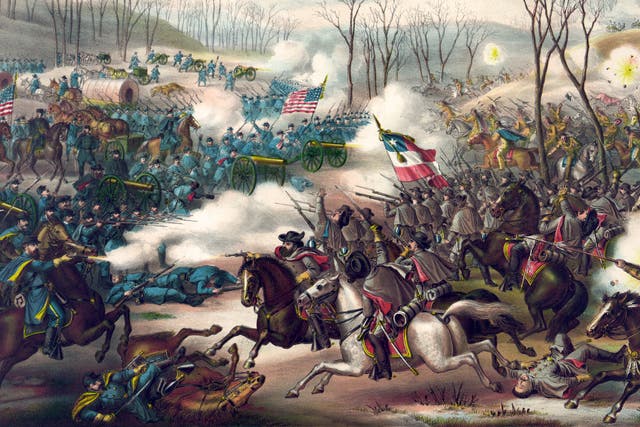
Most tribal leaders in Indian Territory aligned with the Confederacy, but a Home Guard unit arose to support the Union.
Updated: July 12, 2023 | Original: November 23, 2020

The American Civil War wasn’t just a conflict between white citizens of the Union and the Confederacy. Spilling over into Indian Territory, on the western frontier of the war, it profoundly divided Indian nations, communities and families. An estimated 20,000 Native American soldiers participated in the conflict, fighting for both sides.
At the outset of the war, many nations in Indian territory signed treaties with the Confederacy—supported by a minority of wealthy slave-holding Indians within their communities. But those sympathies weren’t unanimously shared: Many Indians leaned toward ending slavery and expressed a wish to be independent from the U.S. and its bloody conflict. As the war progressed, though, momentum shifted. Three Indian Home Guard regiments emerged to support the Union and protect vulnerable tribal communities from violent guerrilla warfare. The result: Indians fighting Indians in a white man’s war.
The Civil War and Its LegacyNative American soldiers went to battle for a variety of reasons: to support or fight slavery, to defend tribal sovereignty and to protect family and community. But the war did little to advance their own needs and interests. Instead, it aggravated longstanding internal tribal tensions and ravaged territory the U.S. government had relocated them to decades earlier, creating a new wave of impoverished refugees.
When the Civil War broke out in 1861, Indian Territory encompassed most of the area now occupied by the state of Oklahoma. Ancestral home to tribal nations including Osage, Quapaw, Seneca and Shawnee, it had also become the mandated home for the Cherokee, Creek, Choctaw, Chickasaw and Seminole nations (known as the Five Civilized Tribes). Between 1830 and 1850, those groups had been forcibly removed from their ancestral lands in the Southeast and marched hundreds of miles west by the U.S. government. The relocation, later known as the Trail of Tears, killed thousands.
The Cherokee Nation, politically divided since that turbulent period, exemplified how tribal nations were further torn apart by the war. On one side stood Principal Chief John Ross, the leader who had navigated the nation through the Trail of Tears. Supported by nearly a two-thirds majority, he urged neutrality and national unity as the secessionist influence grew in and around Indian Territory. His supporters, organized as the Keetoowah Society, supported abolishing slavery but were motivated by the desire for Cherokee sovereignty.
On the other side: a minority of wealthy slave-holding Cherokees who deeply resented Ross and his failure to align with the Confederacy. Their leader was Stand Watie, longtime head of the Treaty Party, so called because its members, in defiance of the majority, illegally signed the treaty that forced removal of Cherokees from their homelands.
“There had been a smoldering hatred existing between two political factions ever since before the movement of the Cherokees from the old Cherokee Nation,” said tribeswoman Annie Hendrix, interviewed in 1938 as part of a WPA series of oral histories of Indian Territory pioneers. “And when the Civil War broke out, it only afforded an opportunity for the fire of this old feud to burst forth in all its fury.”
In October of 1861, Ross relented to growing pressure and signed a treaty with the Confederate States of America, which promised the Cherokee nation protection, food and other resources in exchange for several regiments’ worth of soldiers and access into their territory for building roads and forts. Unpopular with most Cherokees, the treaty allowed Ross to maintain governmental stability—and stay in power.
Several months earlier, Watie had worked surreptitiously with the Confederacy to form a regiment, the Cherokee Mounted Rifles, mustering several hundred supporters. (He went on to become a brilliant field commander and daring guerrilla leader.) After the treaty, a second regiment of Cherokee Mounted Rifles formed under the command of Ross loyalist Colonel John Drew—a counterbalance to Watie’s growing power and influence.
Meanwhile, a third political force began to mobilize: the “Loyal” Indians, led by Creek chief Opothleyoholo, a staunch advocate of Indian neutrality in the white man’s war. Refusing to ally with the Confederates, he led thousands of followers from multiple tribes, along with escaped slaves and freedmen, to exile in Union-controlled Kansas, where the U.S. government had promised refuge. Along the way, through the fall and winter of 1861, the group endured harsh conditions and defended repeated attacks from Confederate forces, including Watie’s Cherokee Mounted Rifles. But many Cherokees in Drew’s regiment, sympathetic to the Loyal Indians, deserted the Confederacy to join his camp—evidence of the deepening divide between pro-Confederate and pro-Union Indians.
By spring of 1862, James G. Blunt, brigadier general of the Kansas Union forces, wanted to raise an Indian expeditionary force to infiltrate Confederate-ridden Indian Territory. Intel had encouraged his belief that the Cherokee’s Principal Chief Ross was not only sympathetic to the North, but could be persuaded to abandon his Confederate alliance.
So, Blunt ordered the mustering of a 1 st Kansas Indian Home Guard regiment encompassing refugees and survivors of Opothleyoholo’s camp of Loyal Indians. The regiment included nearly 1,800 men, primarily Creeks and Seminoles. Later, a second regiment was raised of nearly 1,500 men, mostly Creeks, Cherokees, Choctaws, Chickasaws and Osages.
The 1st Home Guard expedition soon made its way through Indian Territory toward Tahlequah, the Cherokee Nation capital, and Park Hill, Ross’s home. After repelling Watie’s regiment at the Cowskin Prairie, routing a larger Confederate force in the Battle of Locust Grove and capturing Fort Gibson, they successfully claimed the interior of the Cherokee Nation.
Severe exposure, starvation and disease ravaged tribes during their forced migration to present‑day Oklahoma.